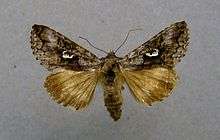Syngrapha interrogationis
Syngrapha interrogationis, the scarce silver Y, is a moth of the family Noctuidae. It is found in the northern areas of the world, from Alaska, through Canada, Iceland, Europe, Siberia up to Northeast Asia including Japan.

| Syngrapha interrogationis | |
|---|---|
 | |
| Scientific classification | |
| Kingdom: | Animalia |
| Phylum: | Arthropoda |
| Class: | Insecta |
| Order: | Lepidoptera |
| Superfamily: | Noctuoidea |
| Family: | Noctuidae |
| Genus: | Syngrapha |
| Species: | S. interrogationis |
| Binomial name | |
| Syngrapha interrogationis | |
| Synonyms | |
| |
Technical description and variation
The wingspan is 32–38 mm. "Forewing bright purplish grey, suffused with black in median area and towards apex; the edges of the stigmata and the lines lustrous grey; inner and outer lines black, double; the inner sinuous above middle, and forming three small curves below it; the outer regularly crenulate throughout; the subterminal line preceded by a conspicuous black dentated and indented line, with a blackish cloud towards apex; a row of pale grey lunules before the terminal marks; the subcellular silvery mark highly variable, either forming a simple loop with fine silvery edge, - ab. orbata ab. nov. [Warren], — or followed by a small silvery dot, as in the type form, or by a large round spot conjoined to it, rarely separate, — ab. flammifera Huene; a development of this last, - ab. ignifera ab. nov. [Warren] — has the usual silvery mark pale yellow, as in some examples of flammifera, shaped like a tadpole, with deep fiery red scaling before the outer line, beyond the inner, and along the submedian fold; hindwing brownish luteous clouded with darker and with a broad blackish border; the type, male from Livonia, is in the Tring Museum; the subsp. transbaikalensis Stgr., from Dauria and East Siberia, is more uniform bluish grey, with very little black suffusion on forewing and paler, hindwings; this form is also recorded from Esthland by Petersen; ab. rosea Tutt, from Scotland, has a rosyground colour in place of bluish grey; ab. cinerea ab. nov. [Warren] has the ground colour dull ashy grey with scarcely any dark markings, except the subterminal line, and no purplish suffusion, the silvery mark a somewhat triangular loop; of this form the Tring Museum possesses three examples from Cedre, Hautes Pyrenees; in the same museum is still another grey form, much resembling cinerea, but with a complete silvery gamma mark and somewhat more developed dark shades; this specimen is from Cauterets in the Pyrenees, and may be distinguished as ab. gammifera ab. nov. [Warren]; these last two grey forms are probably specifically distinct from interrogationis L. "[1]
Subspecies
There are three recognised subspecies:
- Syngrapha interrogationis interrogationis
- Syngrapha interrogationis herschelensis (Benjamin, 1933)
- Syngrapha interrogationis transbaikalensis (Staudinger, 1892)
Biology
The moth flies from June to August depending on the location.
Larva pale green; dorsal line dark, with pale edges; several pale wavy subdorsal lines and a broad whitish lateral line with dark upper edge. The larvae feed on the leaves of various plants, including Vaccinium myrtillus, Vaccinium uliginosum, Betula, Calluna vulgaris, Andromeda polifolia and Urtica.[2]
Montane in northern and central Europe.
References
- Seitz, A. Ed., 1914 Die Großschmetterlinge der Erde, Verlag Alfred Kernen, Stuttgart Band 3: Abt. 1, Die Großschmetterlinge des palaearktischen Faunengebietes, Die palaearktischen eulenartigen Nachtfalter, 1914
- "Robinson, G. S., P. R. Ackery, I. J. Kitching, G. W. Beccaloni & L. M. Hernández, 2010. HOSTS - A Database of the World's Lepidopteran Hostplants. Natural History Museum, London".
External links
| Wikimedia Commons has media related to Syngrapha interrogationis. |